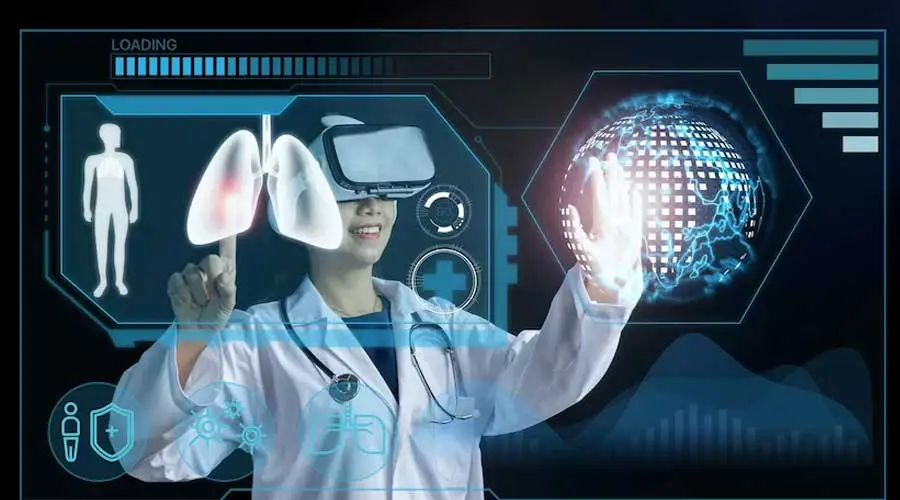AR and VR are transforming the future of healthcare by providing better preventive healthcare solutions and playing a significant role in training and education.
By offering better preventive healthcare solutions and having a substantial impact on training and education, AR and VR are revolutionising the future of healthcare.
The healthcare sector offers creative solutions and uses exponential development to advance human wellbeing to unprecedented heights. The global AR and VR in healthcare market is anticipated to expand more quickly between 2018 and 2025. As a result, it is obvious that AR and VR will change the healthcare sector in the years to come.
AR and VR technology have the potential to revolutionize many industries, including healthcare. With AR and VR, healthcare professionals can gain a better understanding of the anatomy and physiology of their patients. They can also use AR and VR to simulate medical procedures, allowing them to practice in a safe environment before performing them on real patients.
The use of AR and VR technology in the healthcare sector is still in its early stages but it has already shown great promise. The possibilities are endless as new applications are being developed every day. As these technologies become more advanced, they will be used more widely in the healthcare sector for diagnosis, treatment, education, and research purposes..
AR/VR technology is already being used in some hospitals and clinics across the world, and its use is expected to increase as more healthcare providers realize its potential.
These are a few examples of how XR technologies, like as AR and VR, will change the healthcare sector in the future:
Training and facilitation of medical learning
Medical education and learning support Medical professionals‘ learning and training might be considerably improved with XR technology, which could also save expenses and increase retention.
Developing skills through training
Doing physical tasks like inserting catheters, drawing blood, and performing procedures are another component of medical training. With AR and VR technology, students can learn these behavioural skills in a virtual or mixed reality setting by actually executing them, as opposed to acquiring these abilities through textbooks, slide shows, and watching professionals perform them. By practising these abilities in an immersive environment, medical students not only enhance the quality of their learning but also learn to do so with a much greater level of accuracy and precision.
Enhanced surgery or realistic 3D rendering
By giving surgeons access to real-time information on the patient’s vitals, the specifics of the treatment, the locations of the equipment, and other important factors, AR-based apps can increase patient safety during surgery. Doctors may see the locations of a patient’s organs as well as their diseases, tumours, and other abnormalities thanks to AR-based virtual interfaces. Hence, treatments can be completed more quickly while still ensuring patient safety and a doctor’s cognitive conscience. Surgeons need a lot of data and real-time information from sensors, such 3D U/S scans and immediate X-rays, during a TAVI heart treatment, for instance. They can get quick access to such important data sets with AR-based apps.
Representing real-world medical training
Patients who are sceptical or scared can receive interactive and immersive instruction using AR and other XR technology. In addition to teaching tech interns, doctors and other healthcare professionals can utilise VR and AR to educate patients while consulting with them. Patients will be able to make better judgements as a result of the doctors being able to inspire confidence and trust in them.
Better patient care and education
In order to better understand medical issues, specifics regarding therapy, and a range of procedures, AR and VR technologies can be useful to both patients and medical practitioners.
Correct disease and risk diagnosis
Applications based on augmented reality (AR) can help medical professionals identify, prevent, and treat a number of diseases with improved outcomes. To pinpoint the precise reasons of a patient’s condition, it may visualise data gathered from numerous sensors into a single interface. Invasive treatments can be avoided while yet allowing doctors to keep an eye on veins, lesions, organs, and other structures. One such medical software, called EyeDecide, uses the camera display to simulate the effects of various disorders on a person’s vision.
Telemedicine’s capabilities
As more patients rely on virtual visits, telemedicine has grown in importance, and virtual reality has elevated this approach. Medical professionals can now assess patients with motor deficits using VR, such as stroke patients with weak muscles. Virtual reality is being incorporated into telemedicine by businesses, with XRHealth providing as an excellent example. The business combines a VR headgear with enjoyable games to persuade patients to make movements that target particular body parts.
Disclaimer: The content in this piece is strictly the opinion of the author/advertisers and is not intended as investment or trading advice; it is only offered for informational reasons. By using this, you acknowledge that Hotmantra and the crew are not providing investing, financial, or medical advice. Everyone who wants to invest should get independent financial or medical advice from a specialist. Before making any investments or choosing a healthcare provider, do your own research and consult with financial and healthcare professionals. The investment and healthcare views presented in the article are not those of Hotmantra or the team.
